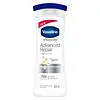Hawaiian Tropic Exotic Coconut After Sun Body Butter Versus Vaseline Intensive Care Advanced Repair Unfragranced Body Lotion
What's inside
What's inside
 Key Ingredients
Key Ingredients

No key ingredients
 Benefits
Benefits

 Concerns
Concerns

 Ingredients Side-by-side
Ingredients Side-by-side

Water
Skin ConditioningGlycerin
HumectantDiisopropyl Adipate
EmollientCetearyl Alcohol
EmollientButyrospermum Parkii Butter
Skin ConditioningMangifera Indica Seed Butter
Skin ConditioningTheobroma Cacao Seed Butter
EmollientCetyl Alcohol
EmollientIsopropyl Myristate
EmollientGlyceryl Stearate
EmollientCocos Nucifera Oil
MaskingPhenoxyethanol
PreservativeCaprylyl Glycol
EmollientPersea Gratissima Oil
Skin ConditioningParfum
MaskingCarbomer
Emulsion StabilisingDicetyl Phosphate
EmulsifyingCeteth-10 Phosphate
CleansingBenzyl Alcohol
PerfumingChlorphenesin
AntimicrobialSodium Hydroxide
BufferingDisodium EDTA
Tocopheryl Acetate
AntioxidantPanthenol
Skin ConditioningAloe Barbadensis Leaf Juice
Skin ConditioningPsidium Guajava Fruit Extract
AstringentPlumeria Acutifolia Flower Extract
Skin ConditioningPassiflora Incarnata Fruit Extract
Skin ConditioningMangifera Indica Fruit Extract
Skin ConditioningCarica Papaya Fruit Extract
Skin ConditioningBenzyl Cinnamate
PerfumingCI 19140
Cosmetic ColorantCI 15985
Cosmetic ColorantWater, Glycerin, Diisopropyl Adipate, Cetearyl Alcohol, Butyrospermum Parkii Butter, Mangifera Indica Seed Butter, Theobroma Cacao Seed Butter, Cetyl Alcohol, Isopropyl Myristate, Glyceryl Stearate, Cocos Nucifera Oil, Phenoxyethanol, Caprylyl Glycol, Persea Gratissima Oil, Parfum, Carbomer, Dicetyl Phosphate, Ceteth-10 Phosphate, Benzyl Alcohol, Chlorphenesin, Sodium Hydroxide, Disodium EDTA, Tocopheryl Acetate, Panthenol, Aloe Barbadensis Leaf Juice, Psidium Guajava Fruit Extract, Plumeria Acutifolia Flower Extract, Passiflora Incarnata Fruit Extract, Mangifera Indica Fruit Extract, Carica Papaya Fruit Extract, Benzyl Cinnamate, CI 19140, CI 15985
Water
Skin ConditioningGlycerin
HumectantPetrolatum
EmollientCarbon
Stearic Acid
CleansingGlycol Stearate
EmollientTriethanolamine
BufferingDimethicone
EmollientEthyl Isopropyl-Bicycloheptene-2-Carboxylate
PerfumingTapioca Starch
Cetyl Alcohol
EmollientGlyceryl Stearate
EmollientMagnesium Aluminum Silicate
AbsorbentMethylparaben
PreservativePhenoxyethanol
PreservativePropylparaben
PreservativeDisodium EDTA
Titanium Dioxide
Cosmetic ColorantWater, Glycerin, Petrolatum, Carbon, Stearic Acid, Glycol Stearate, Triethanolamine, Dimethicone, Ethyl Isopropyl-Bicycloheptene-2-Carboxylate, Tapioca Starch, Cetyl Alcohol, Glyceryl Stearate, Magnesium Aluminum Silicate, Methylparaben, Phenoxyethanol, Propylparaben, Disodium EDTA, Titanium Dioxide
Ingredients Explained
These ingredients are found in both products.
Ingredients higher up in an ingredient list are typically present in a larger amount.
Cetyl Alcohol is a fatty alcohol. Fatty Alcohols are most often used as an emollient or to thicken a product.
Its main roles are:
Though it has "alcohol" in the name, it is not related to denatured alcohol or ethyl alcohol.
The FDA allows products labeled "alcohol-free" to have fatty alcohols.
Learn more about Cetyl AlcoholDisodium EDTA plays a role in making products more stable by aiding other preservatives.
It is a chelating agent, meaning it neutralizes metal ions that may be found in a product.
Disodium EDTA is a salt of edetic acid and is found to be safe in cosmetic ingredients.
Learn more about Disodium EDTAGlycerin is already naturally found in your skin. It helps moisturize and protect your skin.
A study from 2016 found glycerin to be more effective as a humectant than AHAs and hyaluronic acid.
As a humectant, it helps the skin stay hydrated by pulling moisture to your skin. The low molecular weight of glycerin allows it to pull moisture into the deeper layers of your skin.
Hydrated skin improves your skin barrier; Your skin barrier helps protect against irritants and bacteria.
Glycerin has also been found to have antimicrobial and antiviral properties. Due to these properties, glycerin is often used in wound and burn treatments.
In cosmetics, glycerin is usually derived from plants such as soybean or palm. However, it can also be sourced from animals, such as tallow or animal fat.
This ingredient is organic, colorless, odorless, and non-toxic.
Glycerin is the name for this ingredient in American English. British English uses Glycerol/Glycerine.
Learn more about GlycerinGlyceryl Stearate is a mix of glycerin and stearic acid.
It is used to stabilize the mixing of water and oil ingredients. By preventing these ingredients from separating, it can help elongate shelf life. It can also help thicken the product's texture.
As an emollient, it helps soften skin and supports barrier-replenishing ingredients.
In cosmetics, Glyceryl Stearate is often made from vegetable oils or synthetically produced.
This ingredient may not be fungal-acne safe
Fun fact: The human body also creates Glyceryl Stearate naturally.
Learn more about Glyceryl StearatePhenoxyethanol is a preservative that has germicide, antimicrobial, and aromatic properties. Studies show that phenoxyethanol can prevent microbial growth. By itself, it has a scent that is similar to that of a rose.
It's often used in formulations along with Caprylyl Glycol to preserve the shelf life of products.
Water. It's the most common cosmetic ingredient of all. You'll usually see it at the top of ingredient lists, meaning that it makes up the largest part of the product.
So why is it so popular? Water most often acts as a solvent - this means that it helps dissolve other ingredients into the formulation.
You'll also recognize water as that liquid we all need to stay alive. If you see this, drink a glass of water. Stay hydrated!
Learn more about Water